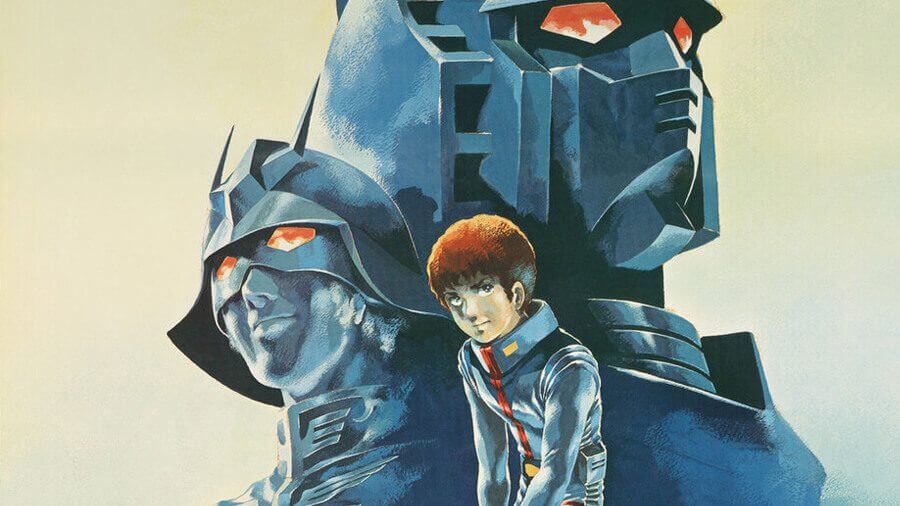[Week 1] Mobile Suit Gundam I (1981 film)

For the film club I do with friends, I'm picking a series of selections from the Mobile Suit Gundam franchise. Because not all of us are anime buffs, I figured I'd write some short intros for each thing I plan to have us watch, to provide a bit of context and explanation. The intros got a bit longer than I'd anticipated (probably because I was procrastinating working on another thing I should have been working on instead). Since I ended up being really happy with what I wrote, I thought I'd share them with a wider audience here on the blog.
Week 0 | Week 1 | Week 2 | Week 3 | Week 4 | Week 5
This week, we start at the beginning, or at least a version of it. The original Mobile Suit Gundam, known by fans as “First Gundam”, originally ran as a TV series in 1979, but was later adapted as a trilogy of films. We'll be watching the first of those films: 1981's “Mobile Suit Gundam I”.
Rip your calendar off the wall and throw it in the garbage, because the boring old AD calendar era is done. Welcome to the Universal Century or “UC” era, the age of human expansion into space. First Gundam revolves around the One Year War, a conflict in the year UC 0079 between the Earth Federation and its former colony, the Principality of Zeon.
They're Not "Toys", They're "Gunpla"
With First Gundam, creator Yoshiyuki Tomino wanted to depict the harsh realities and human impact of war. So why, you might ask, would he use cool giant robots for that purpose? The answer, of course, is merchandising.
First Gundam was produced by Nippon Sunrise, an animation studio founded in 1972. Despite its junior status compared to veteran Japanese animation houses founded in the 40s like TMS and Toei Animation, Sunrise had carved out a comfortable niche producing super robot shows. Other studios had been shy to embrace the genre, since robot fights were expensive to animate, but Sunrise made production of their shows feasible through lucrative sponsorship deals. Clover, a manufacturer of plastic robot figures, partnered with Sunrise to fund several super robot shows, and in 1979 they provided the bulk of the funding for First Gundam.
Unfortunately for Clover, First Gundam wasn't really all that similar to the shows with which they had previously launched successful super robot toy lines. That's because it wasn't a "super robot" show, it was the show that defined the contrasting "real robot" genre, but they didn't know that, it's a distinction that can only be made in retrospect. The difference in tone and subject matter hindered attempts to market the show and toys to their assumed target audience of middle school kids, so neither the toys nor the show were a hit. Clover pulled funding, and the series order was cut from 52 episodes to 43.
But after the show went off the air, two things revived interest in Gundam.
First, a different merchandising line became a runaway success: Bandai’s Gundam Plastic Model kits, or “Gunpla”, which premiered in 1980, months after the finale. Unlike Clover's pre-assembled toys, Gunpla model kits appealed to older kids and young adults who had a more favorable opinion of the show. The kits even garnered interest from model-building hobbyists who hadn't watched the show.
Second, in 1981, Sunrise released a trilogy of compilation films retelling the story of First Gundam, primarily using re-edited footage from the series. The films were hits, and some regard them as the superior version of First Gundam.
Based on the success of the films and the Gunpla models, Sunrise struck a new sponsorship deal with Bandai, leading to the sequel series "Zeta Gundam" in 1985. From there, dozens of other series and films followed, and Gundam has been enduringly popular ever since. Bandai (who now owns Gundam outright after buying Sunrise in 1994) reported last month that Gundam and Gunpla products hit record sales numbers during the 2022-2023 fiscal year.
Wait Hold On, Maybe I Was Wrong About Some Of That
To summarize the commonly shared version of the franchise history: It failed to reach an audience during its run, it only garnered a following when model hobbyists became interested, and that paved the way for a successful film launch and the franchise's subsequent meteoric rise. A neat story? Sure. But is it true or is it reductive, revisionist bullshit?
Series creator Yoshiyuki Tomino indicated that it may be the latter, and he has attempted to correct the record in several interviews. According to Tomino, Gundam always had a following, even before the gunpla crowd showed up. It just didn’t have much of a male following. Early enthusiasm from the show, according to Tomino, primarily developed among women and girls.
I can't find much discussion about this early female fandom on the English speaking internet, but a few Reddit and forum posts addressing Tomino's comments on the subject seem to validate its plausibility. Some fans of 70s shoujo anime and manga (meaning, anime and manga targeted at girls and young women) have pointed out aesthetic and narrative similarities between First Gundam and the trend of period romantic melodrama series, popular with the shoujo demographic at the time. My takeaway from this is that maybe I should start getting into 70s shoujo? "The Rose of Versaille" doesn't seem to have a single giant robot in it, but other than that it looks kind of sick.
In any case, based on what familiarity I have with the history of English speaking science fiction fan communities in the 20th century, I find it pretty plausible that the contributions of women and girls to 70s and 80s Gundam fandom have been ignored and erased.
Mobile Suit Gundam I (1981)
To begin this sampler, we’ll be watching Mobile Suit Gundam I (1981), the first film in the aforementioned trilogy adapting the original 1979 series. I’m not planning on having us watch the rest of the trilogy, we'll be sampling from elsewhere in the franchise, so be prepared not to learn how the war ends.
The film condenses the first 13 episodes of First Gundam into about 40% of the running time, but that’s still pretty long for an animated film at 2 hours 20 mins, so plan accordingly. I’ve seen the original series but I’ve never seen the compilations, so I’m curious how much this will feel like a cohesive movie with a beginning, a middle, and an end.
You can watch the film on Netflix with the original Japanese audio. An English dub was released in 1998, but it's not on Netflix. If you prefer a dub and you can find it, then it might be worth a try, but be forewarned that opinions on its quality vary.
One last bit of trivia: the original pitch for this series was called “Freedom Fighter Gunboy”. I’m glad they didn’t call it that.
Incidentally, I didn't end up being a huge fan of the way this movie condensed the TV series. In the conversion, a lot of the less "important" details of First Gundam are sacrificed, and that's where a lot of the show's personality lives in my opinion. Also, as I'd worried, it felt a bit structureless, like a succession of scenes that didn't seem to have the kind of dramatic build you'd want from a movie. Among the rest of movie club, opinions varied. Some were really into it (which was a nice surprise to me!), some were interested in it in some of the ideas but didn't find the movie itself that engaging, and at least one of us was just bored by the whole thing.
Next: [Week 2] Mobile Suit Gundam 0080: War In The Pocket (1989 OVA)

Member discussion